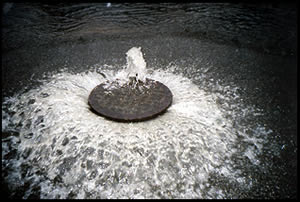Infiltration may refer to:
Infiltration may refer to:

Urban exploration is the exploration of manmade structures, usually abandoned ruins or hidden components of the manmade environment. Photography and historical interest/documentation are heavily featured in the hobby and it sometimes involves trespassing onto private property. Urban exploration is also called draining, urban spelunking, urban rock climbing, urban caving, building hacking, or mousing.
TI, ti, and variants may refer to:
XX or xx may refer to:
Fluke may refer to:

A blower door is a machine used to measure the airtightness of buildings. It can also be used to measure airflow between building zones, to test ductwork airtightness and to help physically locate air leakage sites in the building envelope.
ABL may refer to:

A revolving door typically consists of three or four doors that hang on a central shaft and rotate around a vertical axis within a cylindrical enclosure. Revolving doors are energy efficient as they, acting as an airlock, prevent drafts, thus decreasing the loss of heating or cooling for the building. Revolving doors were designed to relieve the immense pressure caused by air rushing through high-rise buildings while at the same time, to allow large numbers of people to pass in and out.
An arch is a curved structure capable of spanning a space while supporting significant weight.
A leakage occurs when fluid is lost through a leak.
ALSA or alsa can refer to:
Infiltration is the diffusion or accumulation of foreign substances in amounts excess of the normal. The material collected in those tissues or cells is called infiltrate.

Jeff Chapman, better known by the pseudonym Ninjalicious, was a Toronto-based urban explorer, fountaineer, writer and founder of the urban exploration zine Infiltration: the zine about going places you're not supposed to go. He was also a prominent author and editor for YIP magazine, as well as its website, Yip.org.
Bleeding usually means the leakage or loss of blood from the body.

The 125th Special Tactics Squadron is a special operations force unit serving as part of the 142nd Fighter Wing of the United States Air National Guard. They are based at the Portland Air National Guard Base in Portland, Oregon.

Infiltration/Inflow (I/I) causes dilution in sanitary sewers. Dilution of sewage decreases the efficiency of treatment, and may cause sewage volumes to exceed design capacity. Although inflow is technically different from infiltration, it may be difficult to determine which is causing dilution problems in inaccessible sewers. The United States Environmental Protection Agency defines the term infiltration/inflow as combined contributions from both.
Jasmine Movement may refer to:

The 21st Infantry Regiment, Queen Sirikit's Guard is an elite force King's Guard regiment under the 2nd Infantry Division, Queen Sirikit's Guard of the Royal Thai Army. They are trained like special operations forces. The regiment was created in 1950. It is known as the Queen's Guard or Thahan Suea Rachini. It is sometimes referred to as the "Eastern Tigers". The regiment is based in Chonburi.
Fresh Air is a 1999 Australian film.
Infiltrator or variations thereof may refer to:
Building airtightness can be defined as the resistance to inward or outward air leakage through unintentional leakage points or areas in the building envelope. This air leakage is driven by differential pressures across the building envelope due to the combined effects of stack, external wind and mechanical ventilation systems.